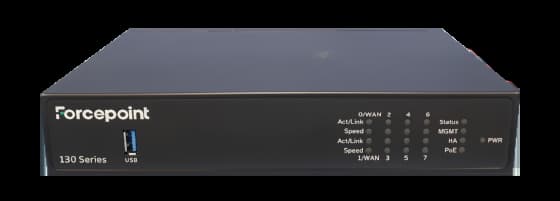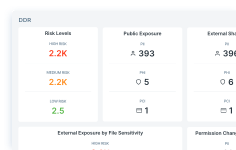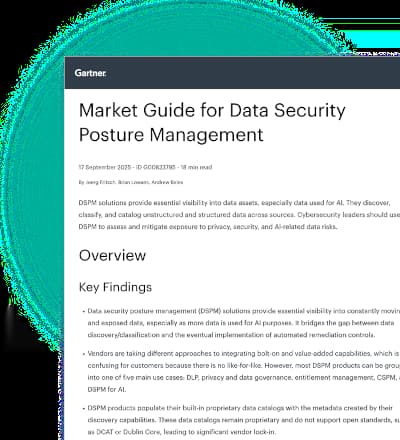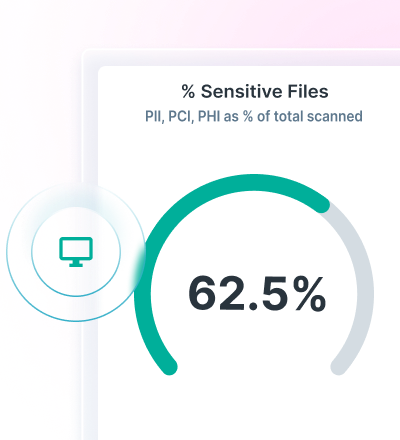
Über 12.000 Kunden können sich nicht irren










































Netzwerkzugriff für Büros, Zweigstellen und Remote-Standorte skalieren und sichern.
Wide Area Networking trifft auf Sicherheit. Forcepoint Secure SD-WAN schützt das Netzwerk vor fortschrittlichen Bedrohungen mit Zero-Trust-Sicherheitsmaßnahmen und gewährleistet gleichzeitig weltweit eine erstklassige Konnektivität.
Warum Forcepoint Secure SD-WAN?
Zentralisiertes Management: Aktivieren Sie Niederlassungen, Büros und Remote-Standorte über die Cloud. Konfigurieren Sie Richtlinien einmal und nutzen Sie eine Zero-Touch-Bereitstellung mit der Secure Management Console (SMC).
Verbessern Sie die Anwendungsleistung: Reduzieren Sie Latenz und Jitter und stellen Sie sicher, dass kritische Anwendungen Bandbreitenpriorität durch Multi-Link-Konnektivität, dynamische Verkehrssteuerung, Anwendungszustandsüberwachung und andere Funktionen erhalten.
Schutz vor erweiterten Bedrohungen: Erkennen und verhindern Sie Risiken mithilfe einer Untersuchung auf mehreren Schichten, Intrusion Prevention, DNS-Sinkholing und mehr, während Sie gleichzeitig den Zugriff auf Anwendungen vor Ort oder remote über den ZTNA Application Connector sichern.
Reduzieren Sie Betriebskosten: Senken Sie Netzwerkkosten und verbessern Sie die Zuverlässigkeit durch Echtzeit-Kombination und -Abgleich von lokalem ISP-Breitband und privater MPLS-Auswahl.
Datenblatt
Appliance-Modelle vergleichen


Global Network
20+
Countries
45+
Cluster Nodes
Clustering In a Way No One Else Can Do
Christian Keller, CISO at Huber + Suhner, lists reliability, clustering, and ability to navigate global compliance requirements among the top benefits of Forcepoint NGFW.
Forcepoint Secure SD-WAN-Modelle erkunden

3500-Serie
Ideal für große Unternehmen, Campusnetzwerke und Rechenzentren.
Bis zu 66 Schnittstellen
Firewall-Durchsatz bis zu 600 Gbit/s
IPS NGFW-Durchsatz bis zu 140 Gbit/s

3400-Serie
Ideal für Campusnetzwerke und Rechenzentren.
Bis zu 67 Schnittstellen
Firewall-Durchsatz bis zu 200-300 Gbit/s
IPS NGFW-Durchsatz bis zu 15-35 Gbit/s

2200-Serie
Ideal für mittlere und große Büros.
Bis zu 25 Schnittstellen
Firewall-Durchsatz bis zu 120 Gbit/s
IPS NGFW-Durchsatz bis zu 13,5 Gbit/s

1200-Serie
Ideal für mittlere und große Büros.
Bis zu 17 Schnittstellen
Firewall-Durchsatz bis zu 65 Gbit/s
IPS NGFW-Durchsatz bis zu 5 Gbit/s

350-Serie
Ideal für Remote-Standorte und Zweigstellen (Desktop-Design).
Bis zu 13 Schnittstellen
Firewall-Durchsatz 40 Gbit/s
IPS NGFW-Durchsatz 2 Gbit/s (N352) oder 4,1 Gbit/s (N355)

130-Serie
Ideal for remote offices, branches and stores.
Bis zu 8 Schnittstellen
Firewall-Durchsatz 8 Gbit/s
IPS NGFW-Durchsatz 1,600 Mbps

120-Serie
Ideal für stationäre Standorte und Zweigstellen.
Bis zu 8 Schnittstellen
Firewall-Durchsatz 4 Gbit/s
IPS NGFW-Durchsatz 450 Mbit/s

60-Serie
Ideal für Remote Offices, Zweigstellen und Ladengeschäfte.
Bis zu 4 Schnittstellen.
Firewall-Durchsatz 2 Gbit/s.
IPS NGFW-Durchsatz 350 Mbit/s
Cloud-Images:
- Einheitliche Forcepoint NGFW-Software
- Amazon Web Services (AWS)
- Microsoft Azure Lösungen
- Sichert sowohl die Nord-Süd-Kommunikation in die bzw. aus der Cloud als auch den SDN-Ost-West-Datenverkehr
Virtuelle Appliances:
- Einheitliche Forcepoint NGFW-Software
- Verfügbar für KVM und VMware ESXi sowie NSX
- Skalierung bis zu 64 CPUs
- Automatisierte Netzwerk-Mikrosegmentierung
Clustering mit physischen Netzwerken


Der Kaufleitfaden für Secure SD-WAN
Ganz gleich, ob Sie erstmalig kaufen oder ein Upgrade in Betracht ziehen – unser Leitfaden enthält die wichtigsten Kriterien für die Bewertung von Secure SD-WAN-Lösungen. Entdecken Sie die fünf wichtigsten Überlegungen, die Sie berücksichtigen müssen.
Warum sich Kunden für SD-WAN entscheiden
Warum sich Kunden für SD-WAN entscheiden
"Our costs - both for the project and maintenance - are going down because we don't need resources locally, we have centralized everything. If we want new service on a train, we define the policy then give the hardware to the operator, who installs it."
VR Group
Frequently Asked Questions
What is managed SD-WAN?
A managed SD-WAN is a service where a provider handles the deployment, configuration, monitoring and optimisation of your WAN. Meanwhile, a cloud-managed SD-WAN adds centralised control via the cloud, making it easier to apply consistent policies, improve performance and maintain security across distributed networks without internal resource strain. Learn more about this product through our comprehensive managed SD-WAN solutions guide.
What are the benefits of SD-WAN?
Benefits of Forcepoint Secure SD-WAN include the following:
Centralized management
Improved application performance
Protection against advanced threats
Reduced operating costs
How much does SD-WAN cost?
SD-WAN costs are determined by factors, including the type of deployment, the size of the network, the number of locations to connect, the type and amount of data transiting the network and any existing infrastructure that may be leveraged when deploying an SD-WAN solution.
What is SD-WAN security?
SD-WAN security helps organizations enable effortless connection to cloud resources while protecting users, data and IT environments from attack.
What is an SD-WAN solution?
Ad SD-WAN solution applies software-defined networking principles to the wide area network.
What is an SD-WAN provider?
SD-WAN providers enable organizations to deploy SD-WAN technology.
What is an SD-WAN appliance?
SD-WAN appliances are physical or virtual controllers located on-premises or in the cloud that connect an organization’s users to applications, services and workloads.
How do SD-WAN appliances work?
SD-WAN appliances and products are designed to overcome the challenges of ensuring fast and secure connectivity for branch locations and hybrid workforces. The traditional wide area network uses a hub-and-spoke model that requires all traffic to flow through a central data center. For organizations with a highly distributed workforce, this model adds unacceptable levels of latency that negatively affect user experiences and productivity. Additionally, legacy WANs are built with costly Multiprotocol Label Switching (MPLS) connections that are time-consuming to manage and deploy, preventing organizations from scaling easily and cost-efficiently. SD-WAN overcomes these issues by creating a virtual overlay for the network that abstracts network connections and enables the use of additional, low-cost transport services that add redundancy and flexibility.
What is Multiprotocol Label Switching (MPLS)?
Multiprotocol Label Switching (MPLS) is data forwarding technology that increases the speed and controls the flow of network traffic.
What is SD-WAN vs MPLS?
SD-WAN is a networking technology that uses software to make wide area networks more intelligent and flexible by connecting sites directly to the internet over commodity broadband links. Configurations and access policies are centrally managed and easily applied across all sites, removing the need to manual administer each WAN device individually. MPLS is data forwarding technology for network traffic that directs data through a path via labels instead of requiring complex lookups in a routing table at every stop. Traditional networking technology, MPLS, has seen competition from SD-WAN solutions to meet today's high demands and expanding needs for networked business-critical systems.











